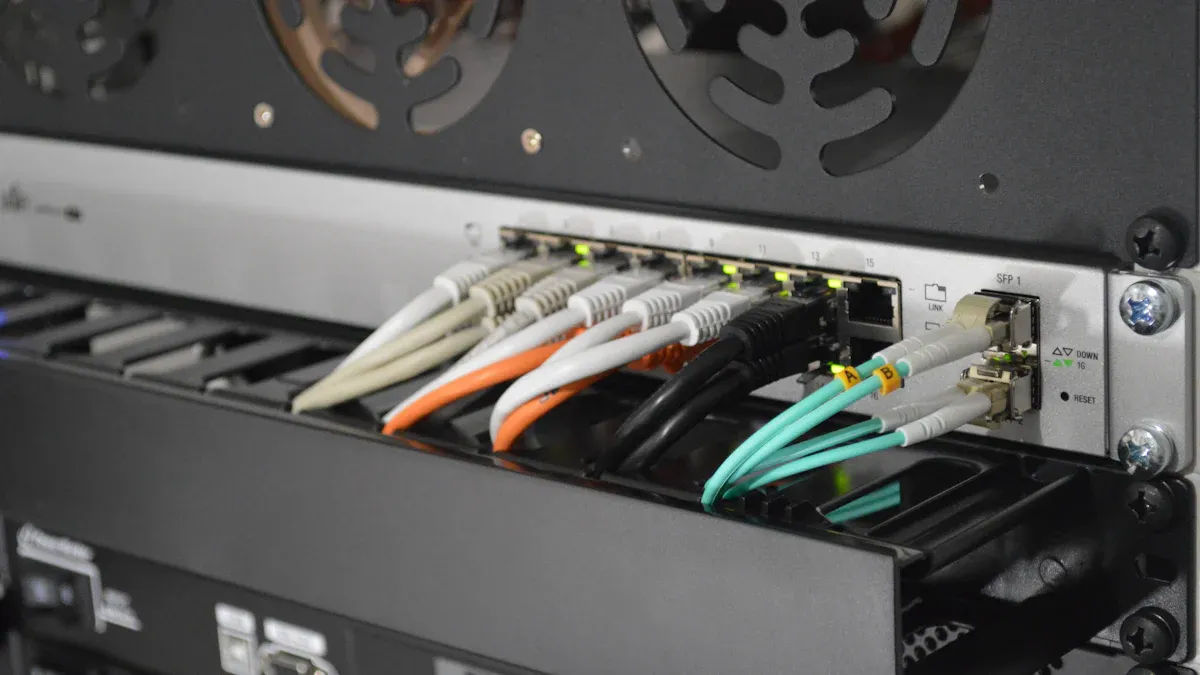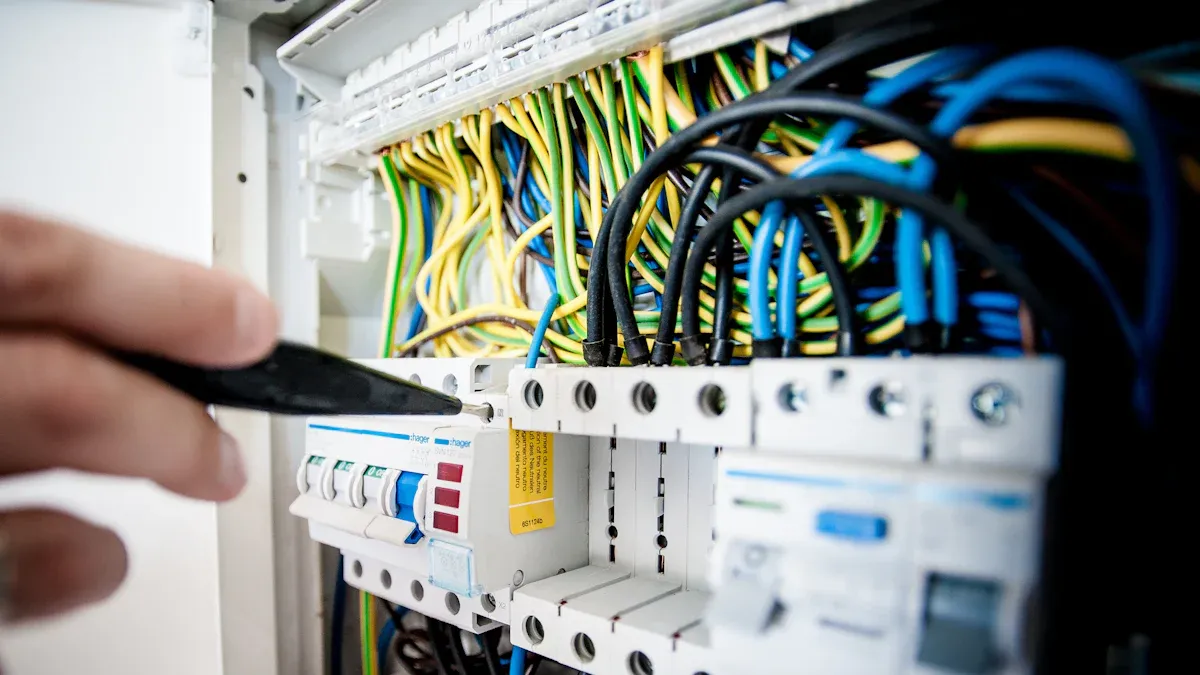
European enterprises face increasing pressure to optimize energy usage and reduce operational costs. Metered PDUs provide a practical solution by enabling real-time power monitoring. These devices help businesses achieve measurable results:
- Bitkom research shows a 30% improvement in energy efficiency through precise power measurement.
- Many organizations report a 20-30% reduction in power costs and carbon emissions after adopting monitored PDUs.
By preventing inefficiencies and ensuring safe power distribution, metered PDUs, including advanced options like the IP PDU, have become indispensable tools for modern enterprises. Smart PDU technology further enhances energy management by offering detailed insights into power consumption patterns.
Key Takeaways
- Metered PDUs can save up to 30% energy, cutting costs and lowering carbon pollution.
- Watching power use in real-time helps find waste, share energy better, and stop overloads.
- Checking each outlet shows how much power devices use, helping split costs fairly and spot weak equipment.
Benefits of Metering at the Inlet
Real-Time Monitoring of Power Usage
Metering at the inlet provides enterprises with the ability to monitor power usage in real time. This capability ensures accurate tracking of key metrics such as voltage, current, and kilowatts. For example, voltage measurements assess power quality, while current readings help identify load efficiency. These metrics, often accessible through modern Smart Pdu interfaces, allow administrators to analyze energy consumption trends over time.
Real-time monitoring also enhances operational efficiency. By identifying inefficiencies, businesses can reduce energy waste and lower costs. Additionally, automation features like load balancing and power capping promote sustainability by optimizing energy distribution. This proactive approach minimizes the risk of equipment failure, ensuring uninterrupted operations.
Avoiding Overloads and Ensuring Stability
Metering at the inlet plays a critical role in preventing circuit overloads. By assessing power usage and available capacity at the rack level, enterprises can avoid exceeding power thresholds. Advanced Smart Pdu systems provide alerts when limits are approached, enabling timely corrective actions.
Facilities using metered PDUs report up to a 20% improvement in energy efficiency. This advancement not only reduces electricity bills but also supports sustainability goals. Furthermore, monitoring tools help calculate efficiency metrics like Power Usage Effectiveness (PUE), ensuring stable and efficient power distribution.
Supporting Energy Efficiency Goals
Metered PDUs contribute significantly to achieving energy efficiency targets. Real-time data helps identify inefficiencies, enabling better capacity planning. Studies show that combining metered PDUs with strategies like server consolidation can enhance data center energy efficiency by 20%.
By improving PUE metrics and reducing greenhouse gas emissions, metered PDUs align with corporate sustainability objectives. Their integration into power management systems ensures enterprises meet both operational and environmental goals effectively.
Advantages of Metering at the Outlet
Identifying Inefficient Devices
Outlet-level metering provides enterprises with precise insights into the power consumption of individual devices. This capability is particularly valuable in data centers, where identifying inefficient devices can significantly reduce energy waste. By monitoring power usage at the outlet, administrators can detect idle or “ghost” servers that consume energy without contributing to operations. This process also enables comparisons of IT equipment efficiency, helping businesses optimize their energy usage.
For example, a data center using outlet metering can identify underperforming servers and replace them with energy-efficient alternatives. This proactive approach not only reduces electricity costs but also supports sustainability initiatives by lowering carbon emissions.
Allocating Power Costs Effectively
Metering at the outlet level enhances the accuracy of power cost allocation. Enterprises can track the energy consumption of specific devices, ensuring that costs are distributed fairly across departments or projects.
| Benefit | Description |
|---|---|
| Detailed Insights | Provides insights into power consumption at the outlet level, enabling accurate billing. |
| Identification of Underutilization | Helps identify ghost servers and underutilized servers for better cost allocation. |
| Efficiency Comparison | Allows comparison of efficiencies of IT equipment, aiding in energy efficiency improvements. |
Facilities using smart PDUs report significant cost savings and improved Power Usage Effectiveness (PUE). These benefits align with sustainability standards like ISO/IEC 30134, making outlet metering an essential tool for modern enterprises.
Enhancing Control Over Device Power Usage
Outlet metering empowers businesses to exercise greater control over device power usage. Administrators can monitor and manage energy consumption remotely, ensuring that devices operate within optimal parameters. This level of control minimizes the risk of equipment failure and extends the lifespan of critical infrastructure.
Smart Pdu technology further enhances this capability by providing real-time data and automation features. Enterprises can implement power capping strategies, schedule device shutdowns during low-demand periods, and ensure compliance with energy efficiency goals. These measures contribute to operational excellence and cost-effective power management.
Role of Smart PDUs in Branch Circuit Metering

Preventing Circuit Overloads
Smart PDUs play a vital role in preventing circuit overloads by offering precise monitoring of power consumption at the branch circuit level. This capability allows IT administrators to track real-time energy usage and identify circuits nearing their capacity limits. Alerts generated by these devices enable timely interventions, reducing the risk of equipment damage and downtime.
By maintaining a balanced load across circuits, enterprises can ensure uninterrupted operations. This proactive approach not only safeguards critical infrastructure but also extends the lifespan of electrical components. Businesses that adopt Smart PDUs report fewer instances of power-related disruptions, contributing to improved operational reliability.
Ensuring Safe Device Integration
Integrating new devices into existing power systems can pose challenges, particularly in high-density environments like data centers. Smart PDUs simplify this process by providing detailed insights into available power capacity at the branch level. Administrators can use this data to allocate resources effectively, ensuring that new devices operate within safe parameters.
This level of precision minimizes the risk of overloading circuits during device integration. It also supports compliance with safety standards, reducing the likelihood of electrical hazards. Enterprises benefit from a streamlined integration process, which enhances overall system stability and performance.
Optimizing Power Distribution
Smart PDUs optimize power distribution by enabling real-time monitoring and analysis of energy usage across outlets, branches, and units. This visibility helps IT teams identify inefficiencies and implement corrective measures.
- Smart PDUs provide granular data on power consumption, aiding in energy conservation.
- Administrators can balance loads more effectively, improving data center productivity.
- Enhanced monitoring capabilities contribute to sustainable energy management practices.
By leveraging these features, businesses can achieve significant cost savings and align with sustainability goals. Smart PDUs empower enterprises to manage power resources efficiently, ensuring both operational excellence and environmental responsibility.
Metered PDUs have become essential for European enterprises aiming to manage power effectively.
By delivering real-time insights at the inlet, outlet, and branch circuit levels, these devices empower businesses to optimize energy usage, cut costs, and meet sustainability objectives.
Adopting metered PDUs ensures compliance with energy standards while driving operational excellence across industries.
FAQ
What is the primary purpose of a metered PDU?
A metered PDU enables real-time power monitoring, helping enterprises optimize energy usage, prevent overloads, and ensure efficient power distribution across devices and circuits.
How do metered PDUs support sustainability goals?
Metered PDUs provide detailed energy consumption data. This insight helps businesses reduce waste, improve Power Usage Effectiveness (PUE), and align operations with environmental standards like ISO/IEC 30134.
Can metered PDUs integrate with existing power systems?
Yes, metered PDUs integrate seamlessly with existing systems. They offer precise capacity insights, ensuring safe device integration and compliance with operational safety standards.
Post time: Mar-29-2025






